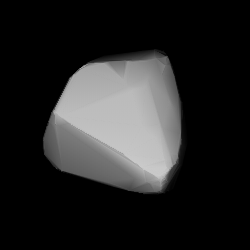Astronomy:1361 Leuschneria
 Modelled shape of Leuschneria | |
| Discovery[1] | |
|---|---|
| Discovered by | E. Delporte |
| Discovery site | Uccle Obs. |
| Discovery date | 30 August 1935 |
| Designations | |
| (1361) Leuschneria | |
| Named after | Armin Otto Leuschner (American astronomer)[2] |
| 1935 QA | |
| Minor planet category | main-belt · (outer)[3] |
| Orbital characteristics[1] | |
| Epoch 16 February 2017 (JD 2457800.5) | |
| Uncertainty parameter 0 | |
| Observation arc | 80.95 yr (29,566 days) |
| |{{{apsis}}}|helion}} | 3.4801 AU |
| |{{{apsis}}}|helion}} | 2.6841 AU |
| 3.0821 AU | |
| Eccentricity | 0.1291 |
| Orbital period | 5.41 yr (1,976 days) |
| Mean anomaly | 16.851° |
| Mean motion | 0° 10m 55.92s / day |
| Inclination | 21.592° |
| Longitude of ascending node | 164.73° |
| 173.35° | |
| Physical characteristics | |
| Dimensions | 29.637±0.199 km[4] 30.16 km (derived)[3] 30.301±0.212 km[5] 32.74±0.41 km[6] 33.47±0.55 km[7] |
| Rotation period | 9.646±0.001 h[8] 12.0893±0.0035 h[9] |
| Geometric albedo | 0.066±0.009[6] 0.077±0.003[7] 0.0773 (derived)[3] 0.0779±0.0154[5] |
| C[3] | |
| Absolute magnitude (H) | 10.80[7] · 11.0[1][3][5][6] · 11.01±0.36[10] |
1361 Leuschneria, provisional designation 1935 QA, is a carbonaceous asteroid from the outer regions of the asteroid belt, approximately 30 kilometers in diameter. It was discovered on 30 August 1935, by Belgian astronomer Eugène Delporte at Uccle Observatory in Belgium, and named after American astronomer Armin Otto Leuschner.[2][11]
Orbit
Leuschneria is a carbonaceous C-type asteroid that orbits the Sun at a distance of 2.7–3.5 AU once every 5 years and 5 months (1,976 days). Its orbit has an eccentricity of 0.13 and an inclination of 22° with respect to the ecliptic.[1] It was first observed at Johannesburg Observatory, extending the body's observation arc by 3 days prior to its official discovery observation at Uccle.[11]
Naming
This minor planet was named after American astronomer Armin Otto Leuschner (1868–1953), on a proposal by Sylvain Arend during a visit to Berkeley, where Leuschner was the director of the Leuschner Observatory at University of California. He is known for his books Celestial Mechanics and The Minor Planets of the Hecuba Group. Naming citation was first mentioned in The Names of the Minor Planets by Paul Herget in 1955 (H 123). The lunar crater Leuschner is also named in his honor.[2]
Physical characteristics
Lightcurve
In May and June 2015, two rotational lightcurves of Leuschneria were obtained from photometric observations by Maurice Clark at Preston Gott Observatory of Texas Tech University, United States, and by Giovanni Casalnuovo at Eurac Observatory (C62) in Bolzano, Italy. Lightcurve analysis gave a rotation period of 12.0893 and 9.646 hours with a brightness amplitude of 0.75 and 0.19 magnitude, respectively ({{{1}}}).[8][9]
Diameter and albedo
According to the surveys carried out by the Japanese Akari satellite and NASA's Wide-field Infrared Survey Explorer with its subsequent NEOWISE mission, Leuschneria measures between 29.637 and 33.47 kilometers in diameter and its surface has a respective albedo between 0.066 and 0.0779.[4][5][6][7] The Collaborative Asteroid Lightcurve Link derives an albedo of 0.0773 and a diameter of 30.16 kilometers with an absolute magnitude of 11.0.[3]
References
- ↑ 1.0 1.1 1.2 1.3 "JPL Small-Body Database Browser: 1361 Leuschneria (1935 QA)". Jet Propulsion Laboratory. https://ssd.jpl.nasa.gov/sbdb.cgi?sstr=2001361. Retrieved 3 April 2017.
- ↑ 2.0 2.1 2.2 Schmadel, Lutz D. (2007). "(1361) Leuschneria". Dictionary of Minor Planet Names. Springer Berlin Heidelberg. p. 110. doi:10.1007/978-3-540-29925-7_1362. ISBN 978-3-540-00238-3. https://archive.org/details/dictionaryminorp00schm.
- ↑ 3.0 3.1 3.2 3.3 3.4 3.5 "LCDB Data for (1361) Leuschneria". Asteroid Lightcurve Database (LCDB). http://www.minorplanet.info/PHP/generateOneAsteroidInfo.php?AstInfo=1361. Retrieved 3 April 2017.
- ↑ 4.0 4.1 Masiero, Joseph R.; Grav, T.; Mainzer, A. K.; Nugent, C. R.; Bauer, J. M.; Stevenson, R. et al. (August 2014). "Main-belt Asteroids with WISE/NEOWISE: Near-infrared Albedos". The Astrophysical Journal 791 (2): 11. doi:10.1088/0004-637X/791/2/121. Bibcode: 2014ApJ...791..121M. http://adsabs.harvard.edu/cgi-bin/bib_query?bibcode=2014ApJ...791..121M. Retrieved 3 April 2017.
- ↑ 5.0 5.1 5.2 5.3 Mainzer, A.; Grav, T.; Masiero, J.; Hand, E.; Bauer, J.; Tholen, D. et al. (November 2011). "NEOWISE Studies of Spectrophotometrically Classified Asteroids: Preliminary Results". The Astrophysical Journal 741 (2): 25. doi:10.1088/0004-637X/741/2/90. Bibcode: 2011ApJ...741...90M.
- ↑ 6.0 6.1 6.2 6.3 Masiero, Joseph R.; Mainzer, A. K.; Grav, T.; Bauer, J. M.; Cutri, R. M.; Nugent, C. et al. (November 2012). "Preliminary Analysis of WISE/NEOWISE 3-Band Cryogenic and Post-cryogenic Observations of Main Belt Asteroids". The Astrophysical Journal Letters 759 (1): 5. doi:10.1088/2041-8205/759/1/L8. Bibcode: 2012ApJ...759L...8M. http://adsabs.harvard.edu/cgi-bin/bib_query?bibcode=2012ApJ...759L...8M. Retrieved 3 April 2017.
- ↑ 7.0 7.1 7.2 7.3 Usui, Fumihiko; Kuroda, Daisuke; Müller, Thomas G.; Hasegawa, Sunao; Ishiguro, Masateru; Ootsubo, Takafumi et al. (October 2011). "Asteroid Catalog Using Akari: AKARI/IRC Mid-Infrared Asteroid Survey". Publications of the Astronomical Society of Japan 63 (5): 1117–1138. doi:10.1093/pasj/63.5.1117. Bibcode: 2011PASJ...63.1117U. (online, AcuA catalog p. 153)
- ↑ 8.0 8.1 Casalnuovo, Giovanni Battista (April 2016). "Lightcurve Analysis for Nine Main Belt Asteroids". The Minor Planet Bulletin 43 (2): 112–115. ISSN 1052-8091. Bibcode: 2016MPBu...43..112C. http://adsabs.harvard.edu/cgi-bin/bib_query?bibcode=2016MPBu...43..112C. Retrieved 3 April 2017.
- ↑ 9.0 9.1 Clark, Maurice (January 2016). "Asteroid Photometry from the Preston Gott Observatory". The Minor Planet Bulletin 43 (1): 2–5. ISSN 1052-8091. Bibcode: 2016MPBu...43....2C. http://adsabs.harvard.edu/cgi-bin/bib_query?bibcode=2016MPBu...43....2C. Retrieved 3 April 2017.
- ↑ Veres, Peter; Jedicke, Robert; Fitzsimmons, Alan; Denneau, Larry; Granvik, Mikael; Bolin, Bryce et al. (November 2015). "Absolute magnitudes and slope parameters for 250,000 asteroids observed by Pan-STARRS PS1 - Preliminary results". Icarus 261: 34–47. doi:10.1016/j.icarus.2015.08.007. Bibcode: 2015Icar..261...34V. http://adsabs.harvard.edu/cgi-bin/bib_query?bibcode=2015Icar..261...34V. Retrieved 3 April 2017.
- ↑ 11.0 11.1 "1361 Leuschneria (1935 QA)". Minor Planet Center. https://www.minorplanetcenter.net/db_search/show_object?object_id=1361. Retrieved 3 April 2017.
External links
- Asteroid Lightcurve Database (LCDB), query form (info )
- Dictionary of Minor Planet Names, Google books
- Asteroids and comets rotation curves, CdR – Observatoire de Genève, Raoul Behrend
- Discovery Circumstances: Numbered Minor Planets (1)-(5000) – Minor Planet Center
- 1361 Leuschneria at AstDyS-2, Asteroids—Dynamic Site
- 1361 Leuschneria at the JPL Small-Body Database
 |

